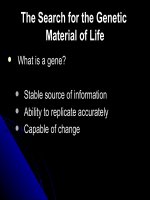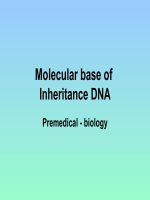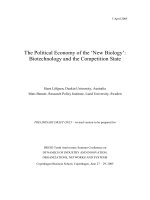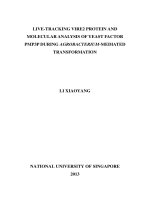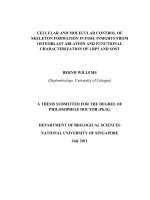Molecular base of Inheritance DNAPremedical - biology
Bạn đang xem bản rút gọn của tài liệu. Xem và tải ngay bản đầy đủ của tài liệu tại đây (2.67 MB, 40 trang )
Molecular base of
Inheritance DNA
Premedical - biology
Proof that DNA is carrier of
genetic information - 1928
•
Griffith‘s experiment - Bacterial transformation
•
Recombination of bacterial genetic material by
transmission of naked DNA into recipient cells
•
Avery, McLeod, McCarthy (1944) – the same effect
with isolated DNA
Streptococcus pneumonie – S strain and R strain
1953 - James D. Watson a Francis Crick
used x-ray diffraction data collected by Rosalind Franklin
•
proposed the double helix as the threedimensional
structure of DNA
•
the main role is the long-term storage of information
•
ability to manage its own replication
•
DNA manage the development of biochemical, anatomical
and physiological and behavioral traits of all known living
organism
Monomers - nucleotides: organic molecule called a
nitrogenous base, a pentose (five-carbon sugar) and
phosphate group
Two families of nitrogenous bases: pyrimidines, purines
Pyrimidine has a six-membered ring of cabron and nitrogen;
Cytosine (C), Thymin (T) and Uracil (U)
Purins the six-membered ring fused to a five-membered ring
Adenin (A), Guanin (G)
Bases - Adenine, guanine and cytosine are found in both
types of nucleic acid. Thymine is found only in DNA and
uracil only in RNA.
Sugars - Ribose in nucleotides of RNA
Deoxyribose in DNA
Nucleoside - nitrogenous base joined to sugar
Nucleotides are bonded by covalent bonds called
phosphodiester linkages between phosphate of one
and the sugar of the next.
Two polynucleotides spiral around imaginary axis to form
double helix
Two polynucleotides are held
by hydrogen bonds between
the paired bases and
by van der Waals attractions
between the stacked bases.
Adenine always pairs with thymine,
Guanine always pairs with cytosine.
Two strands of double helix
are complementary and
are antiparallel.
In preparation for cell division,
each strand serves
as a template to order nucleotides
into a new complementary strand
= Semiconservative replication
Cell cycle
Replication
Origins of replication
•
circular bacterial chromosome has a single origin
•
Replication starts in many places (Eukaryotes)
simultaneously and asynchronnous
•
DNA replication proceeds in both direction
•
At each end of replication bubble is replication fork
•
DNA polymerase – addition of nucleotides only to the
free 3‘ end, new strand can elongate only in one direction
(5´→ 3´) + and correction of mistakes
A new strand in direction 5´→ 3´ leading strand
The other strand – lagging s. is synthetized
discontinuously - Series of segments = Okazaki fragments
enzyme DNA Ligase joins them
Primase -
RNA primers
Helicase
•
One /10 000bp in replication
•
DNA polymerase
•
special enzymes
•
continuous monitoring and repair
•
nucleotid excision repair
Correction of mistakes
Human chromosomes:
22 pairs of autosomes
1 pair of gonosomes (heterochromosomes)
•
Karyotype: men 46, XY, women 46, XX
Euchromatin
•
despiralized in interphase
•
spiralized in mitosis
•
contains structural genes
Heterochromatin
– repetitive sequences
Constitutive – centromers of all
chromosomes
Facultative - structurally
euchromatin, but behaves as
heterochromatin = one of
two X chromosomes in
women = genetically inactive
= X chromatin (sex
chromatin= Barr body)
• DNA
•
Histones – basic proteins
H1,H2A, H2B,H3,H4
• Non-histone proteins
The whole length DNA cca 2 m
human genome contains cca 30 000
structural genes
Ultrastructure of chromosomes
Nucleosome:
DNA double helix + histone core
•
Histone core = octameres of two copies of H2A,
H2B, H3, H4
•
DNA double helix is winded around the core
•
spacer segment DNA between two nucleosomes is
free or associated with H1 histone (appearance of
beads on a string)
Organization of chromatin in interphase
•
String of nucleosomes is coiled into
solenoid (6 nucleosomes in each
turn)
•
Solenoid is packed into loops attached
to the nonhistone protein scaffold
(Laemli loops)
•
nonhistone protein scaffold with loops
is coiled into spiral structure of
chromatides
Karyotype of man - 46,XY – G bands
Chromosome / in metaphase
metacentric submetacentric acrocentric
centromere
p
q
chromatids
telomere
satellite
sat. stalk (NOR)
p = short arm
q = long arm
NOR = nucleolus organizer region (rRNA genes)
Telomeres
•
multiple repetitions of one short nucleotide
sequence TTAGGG [human]
•
telomeric DNA protects genes from being eroded,
protects from fusions
•
telomerase special enzyme
•
reduction of number of telomeres after each
replication
•
abnormal activity of telomerase in tumor cells
